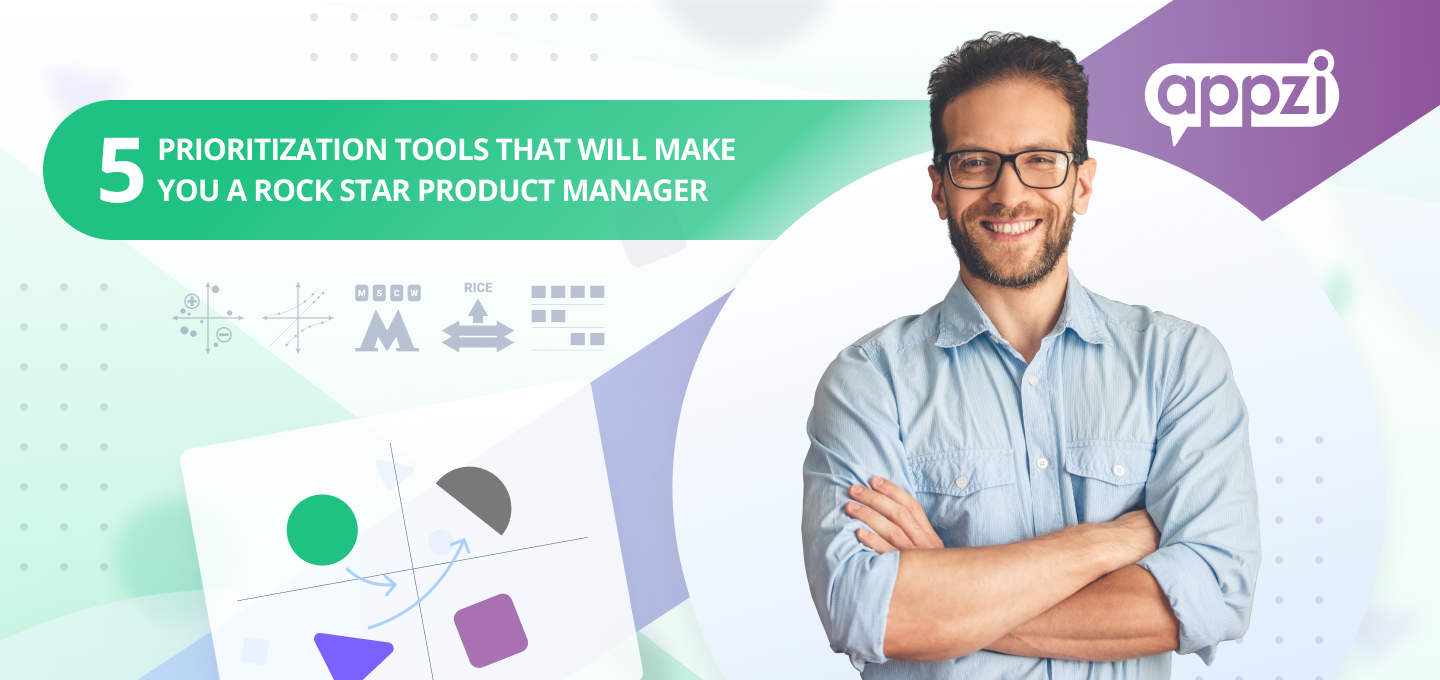5 Feature Prioritization Tools That Will Help You Take Informed Decisions
Innovation leaders and experts argue about Tesla being a disruptor. But whether or not they prove to be a real disruptor, one thing is for sure — the company is seeing a lot of success.
Part of the reason?
Tesla’s superstar CEO himself knows to prioritize features that customers ask for. The proof is when a Tesla owner tweeted about adding a feature related to steering wheel adjustment when the car is parked.
Unfortunately, it’s not every day when a user tweets requesting for a feature to be added. On the other hand, you can always ask for user feedback by using a tool like Appzi.
Here’s the question now:
As a product manager, how will you know which product feature to prioritize? What are the feature prioritization methods you can apply and what tools can help you simplify the process?
Table of Contents
Why prioritize product features?
As the product manager, it’s your job to ensure you’re building the right features for your product in a market that is full of competition.
Here are reasons why it’s important to prioritize product features:
- You have limited resources. There are limits to how much you can produce. Prioritizing your product features will ensure you build the most important ones first before you run out of resources.
- You want to prevent “feature creep”. It’s a term stakeholders use when they don’t know how you would be able to accomplish what you have been tasked with.
- You don’t want to give your competitors a head start and let them ship out a similar product to what you are building simply because you focused on the wrong features first.
- You want to avoid last-minute scrambles when you have already shipped your product. It makes you an inefficient product manager in the eyes of your superiors.
- You don’t want to let down users who are expecting a new feature. Not giving a customer what you have been promising will reduce your product’s credibility and will affect future sales through negative feedback.
How to prioritize product features?
There are dozens of ways you can prioritize product features. As you get started, you might want to experiment with a few product feature prioritization frameworks and use the one that works best for your users, team and product.
But before you begin your feature prioritization method research, here’s what you should know:
Some of the features you, stakeholders and in-house teams see as important might not be valuable to your users.
You should take customer feedback into consideration when prioritizing next product features because first and foremost you’re building the product for your customers. They use the product on a regular basis to solve one or more problems they had before they learned about your solution.
With that in mind, try one of the five most popular feature prioritization methods:
1. Value vs. Complexity Quadrant
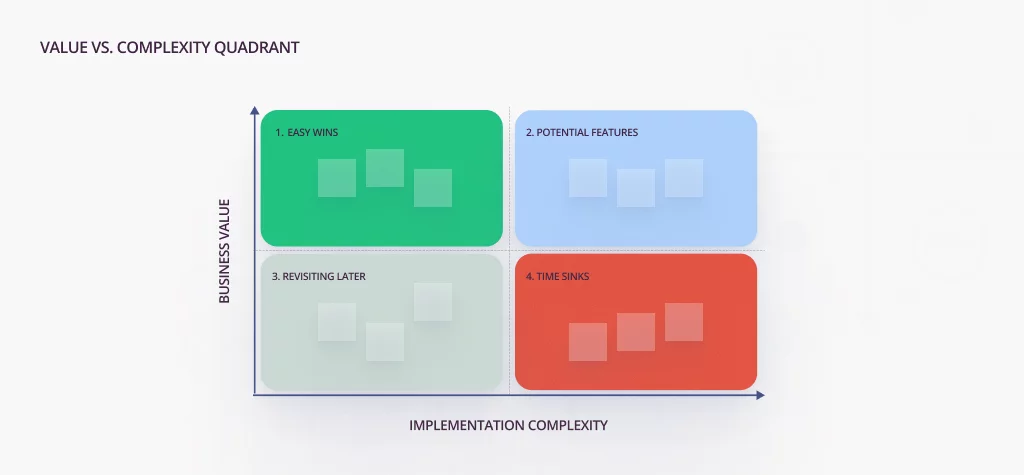
The Value vs. Complexity Quadrant is a method you can use to compare product features based on their return on investment.
This method uses two axes:
- ROI (Return on Investment) is how difficult it’s going to be for you to implement the feature you are comparing against something else in your product. A less difficult-to-implement feature will have a high ROI, while a more difficult-to-implement project will have a low ROI.
- DI (Difficulty of Implementation) refers to how complicated your team’s work will be when you decide to build the feature you are comparing. A less complicated project has a high DI, while an extremely complicated feature will have a low DI score.
If your primary concern in prioritization is to see which product feature would yield the highest return on investment, you should prioritize your features based on the Value vs. Complexity Quadrant.
2. Story Mapping
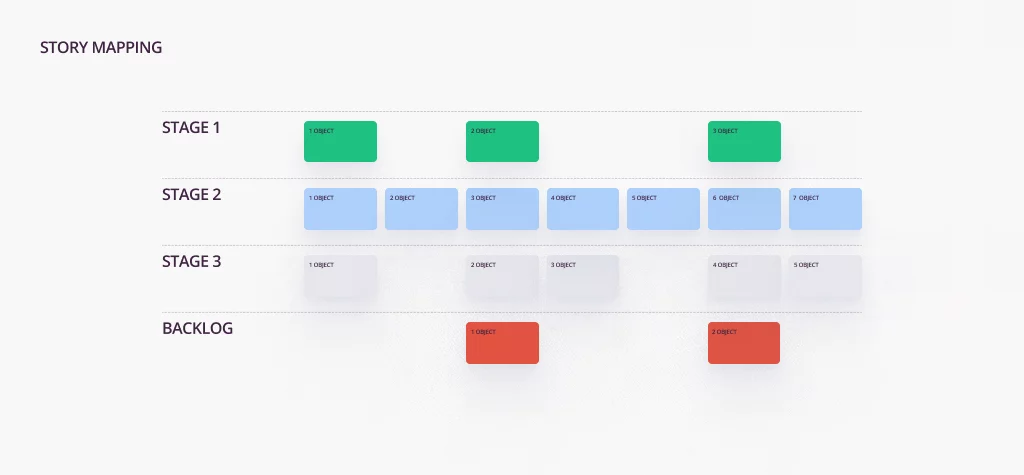
Story mapping revolves around the idea of arranging your product features according to customer value.
In story mapping:
- You list out in a horizontal line the different stages of the customer’s journey with your product. While doing this, think about the actions the customer has to take in each stage.
- Under each stage, specify the tasks in order of importance with the one at the top as the most important. You can also place at the bottom the tasks you want to pause and label them as backlog.
Use story mapping when you want to consider all the stages you want your customer to go through with your product.
3. RICE Scoring
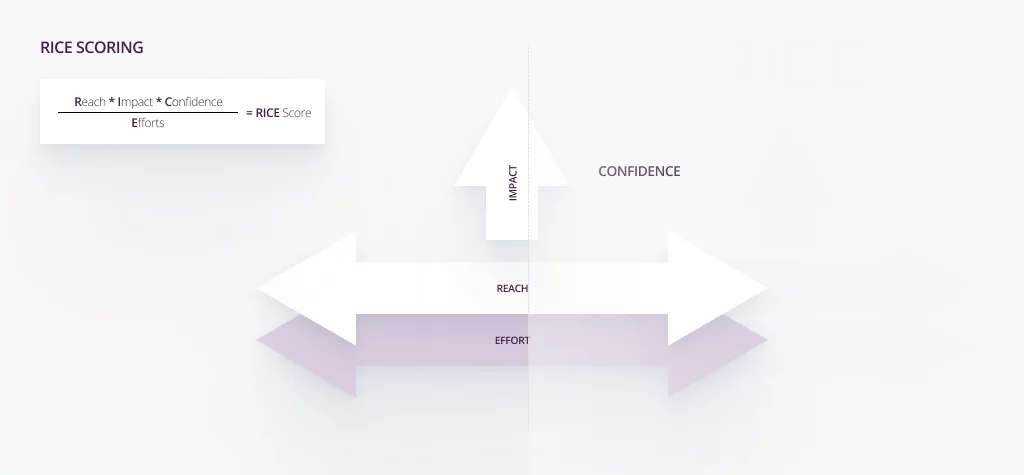
RICE stands for Return, Impact, Confidence, and Ease. This is another method you can use to prioritize your product features according to customer value.
- Return refers to the financial impact of the feature you are comparing. The higher the ROI you expect from a feature, the higher the score must be.
- Impact describes how many users you expect to be affected by your feature. The higher the number of users you want your feature to affect, the higher the score.
- Confidence refers to how confident you are that you can implement this feature given your team’s capacity and timeline. You should score a difficult-to-implement feature low in comparison to a similar feature you are confident you can implement.
- Ease refers to how difficult you expect implementing the feature you are comparing to be. You should score an easy-to-implement feature higher than a complicated product feature you will have to work on.
Use the RICE scoring method when you want to prioritize product features according to customer value, impact on your business, and confidence you have in executing your ideas.
4. MoSCoW Prioritization
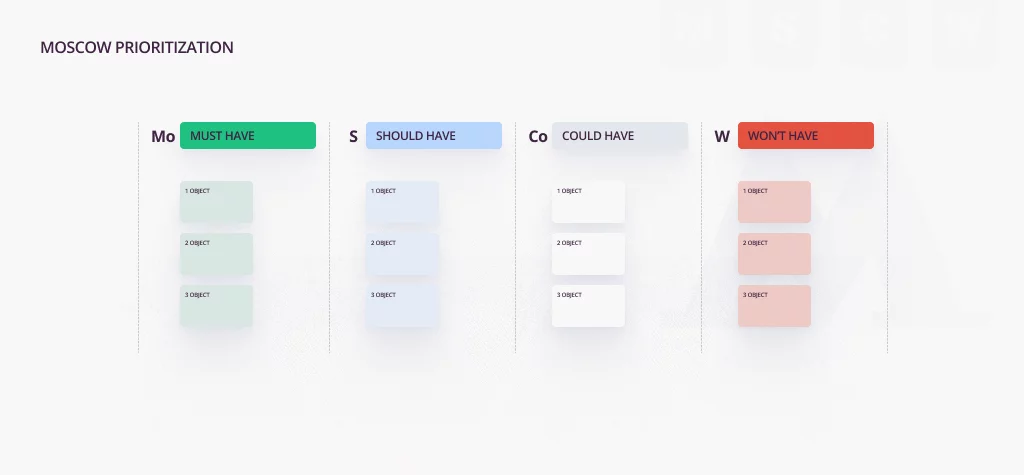
The MoSCow framework is ideal if you want to know which features to prioritize first based on the importance of each feature. Stakeholders without technical expertise would have an easier time understanding your prioritization with this method.
MoSCoW stands for:
- Must-Have: Important features to make the product functional
- Should-Have: Important features but not urgent
- Could-Have: Optional and non-essential features
- Won’t-Have: Least important features but should be considered for future versions
Use MoSCoW if you need to organize your product features based on the importance you place on each one in a simple and logical manner (without taking too much consideration on the urgency).
5. Kano Model
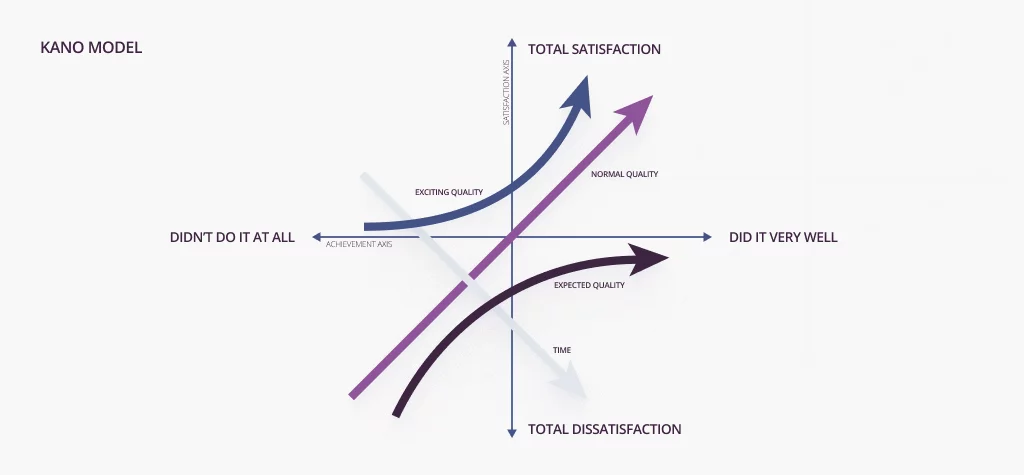
The Kano model tells you which features to prioritize based on how your users feel about your product. It contains guidelines developed by Noriaki Kano and his team in 1984.
The Kano model uses the following categories to rank customer satisfaction with your product:
- Basic needs: Functionalities customers expect on the product
- Performance needs: Features customers expect for some sort of functional improvement in their experience with the product
- Delighters: Features you can add that will give your customers a pleasurable surprise
Use the Kano model if you want to prioritize features based on how your customers feel about your product. The more you give your users what you promise, the happier they will be.
5 Feature Prioritization Tools for Product Managers in 2022
Most product managers end up having a hard time determining which features to prioritize. Fortunately, there are numerous prioritization tools you can use to make your decision-making process much easier.
Here are five of the best ones:
1. Ducalis
Ducalis is a collaborative feature prioritization tool you can use to decide which features to keep based on business value, return of investment (ROI), company revenue, and customer engagement.
It currently packs 14 prioritization frameworks including many of the popular ones like RICE, ICE, and Eisenhower. More features are being added at the moment, which Ducalis proudly shows on its roadmap page.
The interface itself looks good — though it resembles a lot like modern CRM tools as information is displayed in columns. The cool thing is that it has a framework wizard that walks you through your goal and suggests relevant frameworks to use.
Ducalis is ideal if you want to prioritize features you plan on implementing with the user data you gathered. The added benefit is that you can also use it for competitive analysis to see where you stand among your competitors.
Ducalis.io is a task prioritization tool that helps keep your team aligned around top priorities. It ensures that every team member’s opinion is heard and valued. Decisions are made collaboratively, so every team member feels empowered. It offers collaborative prioritization and every team member is involved in the process and their opinion is heard. For each task, you may ask and receive questions from your teammates. This allows you to collect different opinions and spot misunderstandings early on. Our tool offers a large variety of frameworks that you can pick from so you can choose the most optimal one for your team, such as RICE, REAN, ICE, Eisenhower Method, etc. All these frameworks and their criteria are fully customizable and adjustable based on your team’s needs and goals. Ducalis has a team alignment grid that allows you to identify exactly where your team has disagreements. It displays discrepancies in scores so that you may focus on problematic areas. Our platform allows you to sync with your favorite task tracker such as Asana, Jira, Trello with flexible options.
— Alexander Barghouti, Marketing Content and SEO Manager
| Pros: | Cons: |
|---|---|
| Comes with a time-saving framework wizard. | Some users found the tool a bit expensive. |
| Provides integration with a bunch of project management tools. | |
| Factors in what you want to prioritize and how you want to sort out those priorities. |
2. Productboard
Productboard is a lightweight prioritization tool that puts more focus on roadmapping. Through this tool, you will be able to sort and organize various insights from different sources.
The way Productboard works with feature prioritization is slightly different. Instead of selecting frameworks, various methods are integrated and you can create filter views to show only the scoring systems you prefer.
You need to watch out on how you design your views since many of the filters — including those related to feedback and objectives — are locked behind higher, more expensive plans.
The interface looks clean and is quite easy to understand. After playing with the tool for a few minutes, you will have a good idea of which buttons do what. The elements are also arranged neatly, which contributes to the smooth user experience.
Productboard is ideal if you want to use a prioritization tool with in-built roadmap management, progress tracking, and insight analysis.
| Pros: | Cons: |
|---|---|
| Easy-to-use interface. | Productboard would benefit from a larger pool of integrations. |
| View prioritization scores at once from different frameworks. | |
| Features touch most of the stages in the product management job cycle. |
3. airfocus
airfocus is a modular product management tool that allows you to create a customized prioritization framework scoring system. By default, it comes with a set of basic fields for prioritization scoring and with pre-loaded frameworks you can apply.
Using the tool is fairly easy. In fact, it looks like the most simple project management tool out there with the added benefit of columns for various purposes. It also has different views to display data including Kanban, chart, timeline, and others.
airfocus is ideal for product managers who need a flexible tool to prioritize the features while being able to manage and communicate the product strategy with the whole team.
airfocus stands out thanks to:
- “airfocus allows you to create a custom scoring framework that works for your product team and allows you to frame your decision-making process into a conversation everyone can join.
- This includes setting up specific criteria and factors for prioritization based on what the team decides and chooses to use, not forced by the tool at all.
- All prioritized items are given a final score, then mapped out in a helpful impact/effort chart where you can visualize how items compare to one another, providing you with further context when making decisions.
- On top of that, we provide you with useful templates to get you started.
- As a plus, we also have priority poker, another form of prioritization. This involves giving stakeholders the ability to collectively weigh in on the impact/effort of an item, making it an inclusive exercise everyone can be part of.”
— Elise Duchateau, Head of Marketing
| Pros: | Cons: |
|---|---|
| Easy integration with project management apps and feedback management tools. | Some of the titles on the roadmap are limited in length in terms of visibility. When you look at the roadmap view, the titles get cut off. |
| Ability to create custom scoring systems. | |
| Provides a lot of visuals to show data in different ways. |
4. Aha!
Aha! is a complete product management suite with a feature prioritization tool that lets you organize, detail, and score product features. Each entry has an overall score taken from various metrics.
The scorecard in Aha! is completely customizable and is one of the most advanced in the market. The sequence type for each metric can be customized and you can add your own advanced equation to get the total score of all metrics.
The downside is that this tool doesn’t have any preloaded prioritization frameworks you can use. In addition, each metric can only be graded with a scoring slider or a chart — although you can always customize the value range, units, and step value.
As for the interface, the tool looks simple, with a clean look on its boards. You can also change the view from board to a roadmap in two clicks and customize what to show on a specific date range.
Use Aha! if you want a complete suite for product management instead of a stand-alone app. It’s also ideal if you have a custom scoring system you want to implement — no matter how advanced it may seem to be.
| Pros: | Cons: |
|---|---|
| Advanced, customizable scoring system. | The search functionality seems to be lacking, because when you have many feature requests as a company, it’s hard to find ones that already exist. |
| Comes with a dependency feature that connects features to various records. | |
| Contains all the tools you need to take an initial idea to completion. |
5. ProdPad
ProdPad is a product management software and a road mapping tool for teams and businesses. It has a simple feature prioritization scoring system that uses a variant of the value vs. complexity quadrant method.
For each feature, you can indicate its impact and effort with a scale. The default scale follows the Fibonacci Sequence. Changing the type of scale is not that intuitive as you have to do it from the account settings.
For every feature that has an impact score and an effort score, you will be able to visualize them in a priority quadrant chart that shows you which ones are quick wins and time sinks.
The software itself is easy to use with its default functions and settings. You may struggle a little bit when you need to change a few things since many of them are hidden behind the account and profile settings.
| Pros: | Cons: |
|---|---|
| Supports integration with a lot of project management apps. | Navigation may be a challenge for first-time users. |
| Ability to build product roadmaps for engineers and executives. | |
| Easy-to-understand prioritization scoring feature. |
Become a Rock Star Product Manager
To become a great product manager, you need the right tools on your side.
There are many different feature prioritization tools available that you can put into action for your team’s next sprint or innovative project. Some may be more suited for you than others depending on what you want from them.
When choosing a tool, consider the product feature prioritization frameworks you want to use. The prioritization tools outlined in this article should give you a good start when it comes to deciding which one is best for you and your business needs.
Of course, what your customers want matters. It’s important to take into account their feedback so you would know which features have more impact on them. Capture insight feedback from your customers with Appzi.
